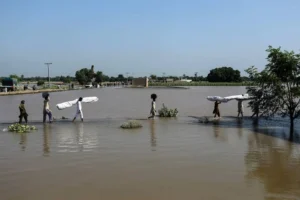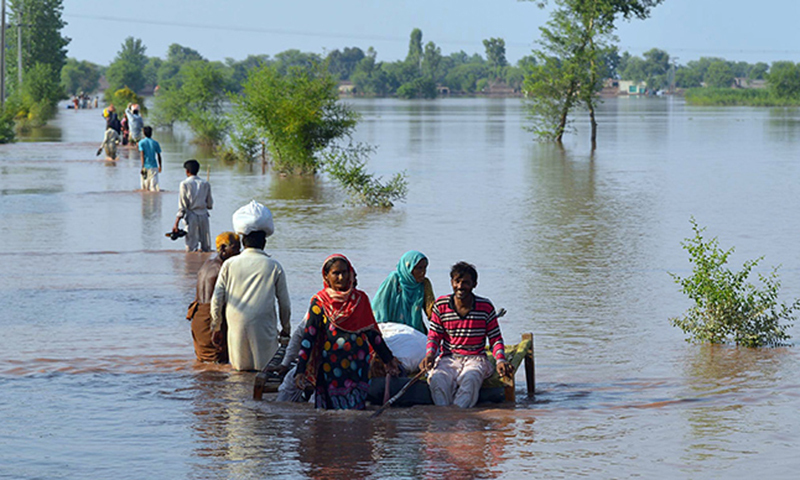Authorities have sounded alarms across several regions of Pakistan after India announced the release of dam waters into downstream rivers. The Provincial Disaster Management Authority (PDMA) has formally issued a Pakistan Flood Warning, urging at-risk communities to remain alert, take immediate precautionary measures, and follow official guidelines.
Local administrations in Punjab and Sindh have already begun emergency preparations, while disaster management teams continue to monitor water flow levels closely. The situation has sparked urgent concerns about the safety of villages along riverbanks and the potential displacement of thousands of people if water levels rise beyond manageable limits.
Background of the Situation
Cross-border river water sharing has long been a sensitive matter between India and Pakistan. Seasonal releases of water are not unusual, but sudden and heavy discharges without prior coordination often cause flooding in downstream regions.
This time, the PDMA has received credible reports that water released from Indian dams may cause a surge in key rivers including the Sutlej, Ravi, and Chenab. As a result, the Pakistan Flood Warning was announced to give vulnerable communities time to prepare before the waters spread further downstream.
Areas Under Threat
According to PDMA’s initial assessment, several low-lying areas in Punjab are expected to experience a significant rise in river levels. Early warning messages have been issued to districts near Kasur, Okara, Bahawalnagar, and Multan. Authorities warn that if river embankments are breached, farmlands and residential settlements could face serious flooding.
In Sindh, officials fear that the Indus River might also experience higher-than-usual discharge rates, eventually affecting regions like Sukkur and Larkana. Emergency services are being mobilized in advance to counter possible consequences if flood levels rise further south.
PDMA’s Response and Measures
The Provincial Disaster Management Authority has activated flood control centers to gather real-time updates and ensure coordination with local administrations. The authority has also directed district officials to:
-
Establish emergency relief camps for displaced families.
-
Guarantee sufficient stock of rescue boats, food, and medical supplies.
-
Deploy mobile health units to areas at immediate risk.
-
Issue clear communication to residents via SMS alerts, mosque loudspeakers, and radio broadcasts.
With the Pakistan Flood Warning now active, the PDMA stressed that timely precautionary steps could significantly reduce the risks of human and material loss.
Government and Political Statements
Government ministers have assured citizens that they are monitoring the situation closely. The Federal Minister for Climate Change highlighted the role of unpredictable weather patterns and upstream dam discharges in creating challenges for flood prevention.
In a press briefing, the minister emphasized the importance of community cooperation:
“Warnings have been issued, camps are being established, and emergency teams are on standby. Citizens must act responsibly and relocate temporarily if directed by officials.”
Meanwhile, opposition leaders have called for greater transparency in cross-border water agreements, stressing that repeated emergencies demand long-term solutions rather than temporary measures.
Community Reactions
On the ground, local residents expressed concern over the announcement of the Pakistan Flood Warning. In rural Punjab, where many villages rely heavily on agriculture, farmers fear devastating crop losses just weeks before harvest season. Families living along riverbanks have begun moving livestock and essential possessions to safer areas preemptively.
Volunteers from civil society organizations are also playing a role, assisting authorities in spreading awareness and arranging temporary shelters. Many are urging the government to improve flood embankments and early warning infrastructure to prevent recurring crises of this scale.
Historical Context of Floods in Pakistan
Pakistan has faced devastating floods in recent decades. The 2010 super floods, for example, displaced nearly 20 million people and damaged critical infrastructure nationwide. Since then, repeated flash floods and monsoon surges have highlighted the importance of timely warnings.
The latest Pakistan Flood Warning is not an isolated occurrence but part of a larger pattern of seasonal vulnerabilities exacerbated by climate change, erratic rainfall, and upstream water releases. Experts argue that without long-term interventions, downstream communities will continue to face recurring emergencies.
Role of Climate Change
Meteorologists note that climate change has increased the unpredictability of flood patterns. Erratic monsoons, heavier glacial melt, and unusual storm activity all put additional pressure on rivers. The Pakistan Flood Warning thus comes at a time when the country is already struggling to cope with overlapping climate disasters.
Environmental experts say comprehensive strategies, including river management agreements, stronger embankments, and climate adaptation policies, are urgently needed to protect vulnerable populations.
Preparedness Tips for Residents
In light of the Pakistan Flood Warning, PDMA and rescue teams have issued several safety instructions for communities:
-
Move to higher ground immediately when instructed.
-
Avoid attempting to cross flooded roads or bridges.
-
Store clean drinking water and dry food in advance.
-
Keep essential documents and emergency contacts secure.
-
Follow official updates from PDMA rather than relying on rumors.
Such measures, officials insist, could reduce loss of life and property during sudden surges.
International Concerns
The release of dam waters has attracted attention beyond Pakistan’s borders. Global humanitarian organizations have begun assessing the situation, offering to extend aid if large-scale displacement occurs. Climate advocacy groups are once again highlighting that Pakistan, though a relatively small contributor to global emissions, remains one of the most climate-vulnerable nations.
International media outlets have also reported on the Pakistan Flood Warning, drawing attention to both the humanitarian and geopolitical aspects of the issue.
Looking Ahead
Experts believe that closer cross-border coordination is essential to prevent such emergencies in the future. While warnings and relief measures are critical, long-term solutions lie in stronger diplomatic engagement, regional agreements on water management, and sustainable infrastructure development.
As communities brace for impact, the coming weeks will test the resilience of Pakistan’s disaster preparedness systems. Much depends on whether flood defenses hold strong and whether official relief operations can reach those most affected.
Conclusion
The Provincial Disaster Management Authority’s decision to announce a Pakistan Flood Warning underscores the seriousness of the threat posed by rising river levels. As downstream communities prepare for possible flooding, the call for caution and preparedness remains more urgent than ever.
While emergency steps may mitigate immediate risks, experts stress that Pakistan needs a broader, long-term strategy to minimize the recurring dangers of river floods compounded by cross-border water releases and climate change.
For now, all eyes remain on river monitoring stations, as citizens hope that precautionary steps will prevent a major crisis from unfolding.

















